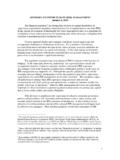Transcription of Booz, Allen, and Hamilton’s New Product Process
1 booz , allen , and hamilton s New Product ProcessLearning ObjectivesAfter examining this chapter, readers will have the ability to: Recognize the importance of nonprofit entities engaging in new Product development as a means of ensuring enduring growth and prosperity. Understand associated barriers to new Product development that complicate such initiatives. Appreciate the value provided by booz , allen , and hamilton s New Product Process , guiding new Product development activities from strategy development and idea generation through that all products possess limited life spans, nonprofit executives must continually seek to develop new Product offerings that will ensure long-term growth and prosperity.
2 These new products, of course, do not automatically appear in the marketplace. Instead, they result from labor intensive, expensive, and bureaucratic efforts that eventually lead to mar-ket entry. Operating plans must be devised; logos must be designed and 1112/29/11 3:54:27 PM Jones & Bartlett Learning, LLC. NOT FOR SALE OR DISTRIBUTION developed; corporations must be formed; building and operating permits must be acquired; property, plant, and equipment must be obtained; and so on, with each of these activities having associated costs. Even if market entry is attained, there are no guarantees of success, as indicated by the high incidence of new Product failure. In addition to the effort, expense, and bureaucracy associated with new Product development, nonprofit entities face yet another concern.
3 Every time new products are introduced to the market, these organiza-tions place their reputations in jeopardy. New products that are poorly developed can be quite damaging to existing offerings, providing an additional incentive for nonprofit organizations to work diligently to ensure new Product riskAlthough risk is inherent in new Product development, it can be lessened by adopting a systematic framework for managing new Product activities. One such framework for managing new Product activities was developed by the management consulting firm of booz , allen , and hamilton (currently known as booz & Company). Illustrated in Figure 2-1, booz , allen , and hamilton s New Product Process divides new Product devel-opment into seven sequential stages: new Product strategy development, Figure 2-1 booz , allen , and hamilton s New Product ProcessFrom New Products Management for the 1980s by booz & Company.
4 Copyright 1982 by booz & Company. Reprinted by permission of booz & Ch a p t e r 2 Bo o z, al l e n, a n d ha m i l t o n s ne w pr o d uC t pr oC e s s 1212/29/11 3:54:28 PM Jones & Bartlett Learning, LLC. NOT FOR SALE OR DISTRIBUTION idea generation, screening and evaluation, business analysis, development, testing, and commercialization. These stages are explained as t a g e 1 : n e w P rO d u c t strategy deveLOPMentBooz, allen , and hamilton s New Product Process begins with the de-velopment of new Product strategies. Here, nonprofit executives lay the foundation for the new Product Process by reviewing missions and associ-ated objectives, identifying roles that new products might play in satisfy-ing given directives.
5 This information clarifies the strategic requirements for new products and provides a point of reference for subsequent new Product development 2: idea generatiOnDuring the idea generation stage, nonprofit executives search for Product ideas that are compatible with the goals and objectives determined in the preceding stage. The idea generation stage usually begins by conducting a self-assessment to determine the Product categories that are of primary in-terest. When areas of interest have been determined, nonprofit executives scan the environment in search of growth opportunities. Ideas should actively be solicited from any potential idea source, including employ-ees, customers, and vendors. The ultimate purpose of the idea generation stage is to produce a wealth of ideas.
6 Every idea should be welcomed and initially considered on a can do 3: screening and evaLuatiOnThe screening and evaluation stage involves the analysis all the ideas gath-ered during the idea generation stage to determine which discoveries should be further investigated. Here, each idea should be envisioned as a Product in the market where it can be evaluated on its potential contribution to given entities. Through screening and evaluation, nonprofit executives seek to narrow down the number of ideas generated during the preceding stage by focusing only on those that offer the greatest this stage, new Product ideas decrease; however, the expenses associated with new Product development increase a trend that st a g e 3: sC r e e n i n g a n d ev a l u a t i o n 1312/29/11 3:54:28 PM Jones & Bartlett Learning, LLC.
7 NOT FOR SALE OR DISTRIBUTION continues through the remaining stages of the new Product Process , as indicated in Figures 2-2 and 2-3, respectively. Organizations can only afford to develop those ideas that possess the greatest potential for success in the market. The most promising ideas proceed to the business analysis stage, and all others are eliminated. Figure 2-2 Mortality of New Product IdeasFrom Management of New Products by booz & Company. Copyright 1968 by booz & Company. Reprinted by permission of booz & 2-3 Cumulative New Product ExpendituresFrom Management of New Products by booz & Company. Copyright 1968 by booz & Company. Reprinted by permission of booz & Ch a p t e r 2 Bo o z, al l e n, a n d ha m i l t o n s ne w pr o d uC t pr oC e s s 1412/29/11 3:54:31 PM Jones & Bartlett Learning, LLC.
8 NOT FOR SALE OR DISTRIBUTION stage 4: business anaLysisDuring the business analysis stage, the most promising Product ideas are subjected to intense scrutiny to determine their potential for translation into viable offerings. Hypothetical business plans that identify Product attributes, barriers to entry, current and potential competitors, target markets, market growth information, financial projections, promotional methods, and so on are created for these offerings in an effort to formulate preliminary recom-mendations. Successful Product ideas graduate to the development 5: deveLOPMentDuring the development stage, Product ideas that have successfully met the scrutiny forwarded during prior stages are translated into actual Product offerings.
9 For goods, development involves the actual physical assembly of the offerings. For services, development involves the assembly of all components required for the services to be offered, such as office space, equipment, operating permits, and personnel. During this stage, Product offerings may go through many alterations a common occurrence when on-paper ideas are translated into real-world offerings. Alterations con-tinue through the remaining stages of the new Product Process as goods and services are readied for the 6: testingTesting seeks to validate earlier projections associated with new offerings through experimentation. Here, new products are readied for market entry by conducting trials to determine marketplace suitability, with the nature of the testing being dependent on the characteristics of the particular products under development and the markets sought.
10 Because of their tangibility, goods are particularly well suited for labo-ratory testing and test marketing a practice where nonprofit executives directly or indirectly seek consumer feedback regarding their new products. For example, an antismoking foundation preparing a comic book targeting the youth that emphasizes the need to abstain from the use of cigarettes and other tobacco products would subject this Product to intensive testing to ensure that it communicates the desired messages effectively. Counselors, antismoking advocates, educators, researchers, and graphic artists would st a g e 4: Bu s i n e s s an a l y s i s 1512/29/11 3:54:31 PM Jones & Bartlett Learning, LLC. NOT FOR SALE OR DISTRIBUTIONbe consulted to ensure message content and effectiveness.

















